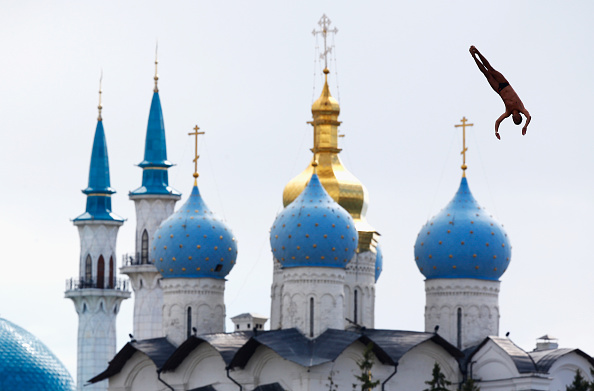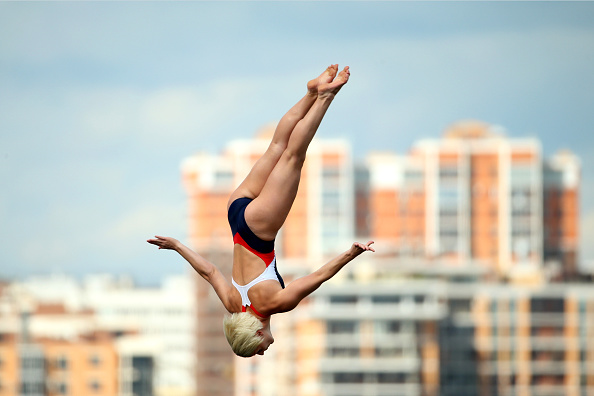KAZAN, Russia — The best female swimmers in the world cover 50 meters, swimming the backstroke, in about 27 seconds. Fatema Abdulmohsen Ahmed Almahme, a 16-year-old from Bahrain, did it in 40.4 in the first-round heats here Wednesday morning. She was last in a field of 52. Afterward, she was thrilled.
“It’s the biggest achievement,” she said, “because I have only been swimming for one year. I never thought about making it here.”
If it’s indisputable that the track and field world championships mark the coming together of the entire world, with athletes from 214 nations, let it be said that Kazan 2015 boasts swimmers from 189. That's up from 177 at the last edition of the swim world championships, in Barcelona in 2013.
Senegal? Mongolia? Tajikistan? Here.
Kosovo? Ethiopia? Laos? Here.
Papua New Guinea? Nicaragua? Namibia? Yep.
Swimming’s diversity outreach — what in Olympic circles is called “universality” — is but a key facet of how all water sports have grown in popularity around the world. With exactly one year to go until the Aug. 5, 2016, start of the Rio Olympics, the water has never been more popular and never enjoyed so many opportunities.
Owing in measure to Michael Phelps, "aquatics," as the sport with its many disciples is known, has now — along with gymnastics — joined track and field in what the International Olympic Committee considers an “A” sport in terms of revenue, the top of the Olympic ladder.
Almost everyone everywhere can walk or run. Swimming, synchro, diving and water polo are obviously more problematic. FINA, swimming’s international governing body, has made concerted efforts in recent years to innovate, to make being in and around the water far more interesting and entertaining — lessons that play out in the experience not just of being in but at the meet.
These are lessons that world-class track and field, among other sports, could stand to learn.
Two years ago, for instance, FINA introduced the high-dive event, its take on action sports. It proved a huge success and now stands at the forefront of any serious discussion about additions to the Olympic program.
There are events for men and women; the men jump off a 88-foot tower, the height of a nine-story building, the women off one just a little lower. It's mandatory to enter the water feet-first -- head-first might, literally, kill you.
In Wednesday's men's final at the Kazanka River, Britain's Gary Hunt won gold. One of his dives: back three somersaults with four twists.
Tuesday's women's final saw American Rachelle Simpson -- who won the high-dive World Cup here a year ago -- take first place.
FINA has also introduced mixed relays, men and women swimming together. That produced two world records in short order Wednesday morning -- first the Russian team, moments later the Americans. At night, the British team won, in 3:41.71, yet another world record.
Halfway through these championships, there have been 10 swimming world records. In Barcelona two years ago, just six.
In the pool Wednesday night, Katie Ledecky added to her amazing run, winning the 200 free in 1:55.16. Italy's Federica Pellegrini took second, American Missy Franklin third.
Ledecky had already won the 400 and 1500; in the 1500, she set two world records, one in the prelims, another in the finals.
The 800, later this week, would appear to be a lock. Understand what Ledecky is doing: not since the great Australian Shane Gould in the 1970s has there been a female swimmer with the range, versatility, power -- and in-pool remorselessness, swimming with zero fear -- that Ledecky is showing here.
Britain's Adam Peaty claimed the 50 breaststroke. He became the first man ever to win the 50 and 100 breaststrokes at a worlds.
China's Sun Yang took the 800 free -- zero surprise, his third straight 800 worlds title. Earlier in the meet, he won the 400 and took second in the 200.
For spectators, Kazan 2015 has featured DJs before the evening sessions whose job it it to amp things up; cheerleaders; mascots (of course, in this instance snow leopards Itil and Alsu); and a “Boss Cam,” the Russian version of a Kiss Cam.
Outside Kazan Arena, the soccer stadium that for the run of the championships features a competition and training pool, there is what’s called “FINA Park,” with food, souvenirs and, pretty much every night, live music. The idea is to turn a swim meet into an experience with your friends or family; FINA Park has been jammed; crowds swarmed the gates just before noon Wednesday, waiting for the park to open.
The athletes — at least those who swim in the evening semifinals and finals — get individually introduced after walking from the plastic chairs in the call room through a dark hall and then out into the noise and light. It's the swimming version of coming in from the baseball bullpen.
It makes for drama and, of course, helps tell the crowd who to root for.
Even for those whose moment in the spotlight is in the morning prelims, it’s all good.
Qatar’s Noah Al-Khulaifi finished last in the men’s 200 fly prelims, at 2:26.71; it was a long way from there up the ranking list to Hungary’s Laszlo Cseh, who recorded the top qualifying time, 1:53.53, and would go on Wednesday night to win the finals over South Africa's Chad le Clos. No matter. Noah, a teen-ager who had felt sick on the plane trip in from Moscow to Kazan, was adopted as a crowd favorite, including an American contingent led by the U.S. standout Conor Dwyer’s parents, Pat and Jeanne.
For 20-year-old Mark Hoare of the African nation of Swaziland, finishing at 59.62 in the 100 free prelims — in 106th place, more than 11 seconds behind the top qualifier, China’s Ning Zelao, at 48.11 — couldn’t have been better.
“It’s an experience unlike any other,” he said. “It’s a great experience meeting the other athletes. And FINA has made us all feel equal.”
He said of his moment under the lights, “I was thinking who at home is watching me. They had better be watching me!”
These championships indisputably underscore the increasingly global reach of swimming. Consider the start lists for the first two heats (of seven) of the men’s 100 backstroke -- not freestyle, the most basic stroke, but the even more technically demanding backstroke.
Heat 1: Lebanon, Kenya, Nicaragua, Uganda, Bangladesh, Qatar, Myanmar, Bahrain, Jordan and the Cook Islands.
Heat 2: Botswana, Azerbaijan, Turkmenistan, Mexico, Macedonia, Jamaica, Morocco, Namibia, the United Arab Emirates and the Dominican Republic.
There is, of course, the matter of swimming. And it is hard to swim 100 meters — two laps of the pool.
Ethiopia’s Robel Kiros Habte, at 1:04.41, finished 115th — out of 115 swimmers — in the 100 free prelims. “The last 50 meters was much too hard for me,” he said.
Then again, he vowed to stick with it: “I want to be famous.”
Giordon Harris of the Marshall Islands finished 99th, in 57.75. This was his third FINA worlds, after Barcelona 2013 and Shanghai 2011. He also competed in the London 2012 Games, in the 50 free, placing 46th.
“This is all I look forward to, all I train for,” he said. “I get to see people I idolize, or I have on posters,” ticking off Brazil’s Cesar Cielho and American Ryan Lochte. “These are the people I see on YouTube. Here I get to swim in the same pool, ride the same bus. It’s a dream come true.”
The Marshall Islands is a remote place, out in the Pacific Ocean, roughly 2,100 miles southwest of Honolulu.
Harris, 22, hails from an atoll called Ebeye. To swim in a pool, he has to go to another island, Kwajalein, 35 miles away, where there’s a U.S. army base. He’s allowed in to the pool, which he said is the only one in the country, three days a week. “Other than that,” he said, “I swim in a lagoon.”
In Bahrain, 16-year-old Fatema said, it’s a struggle still for young women to swim competitively: “Not many know about it.”
When she goes home, she will be in 11th grade. Here, she said, “I learned many things. I have to learn from the best to one day be like them.”







